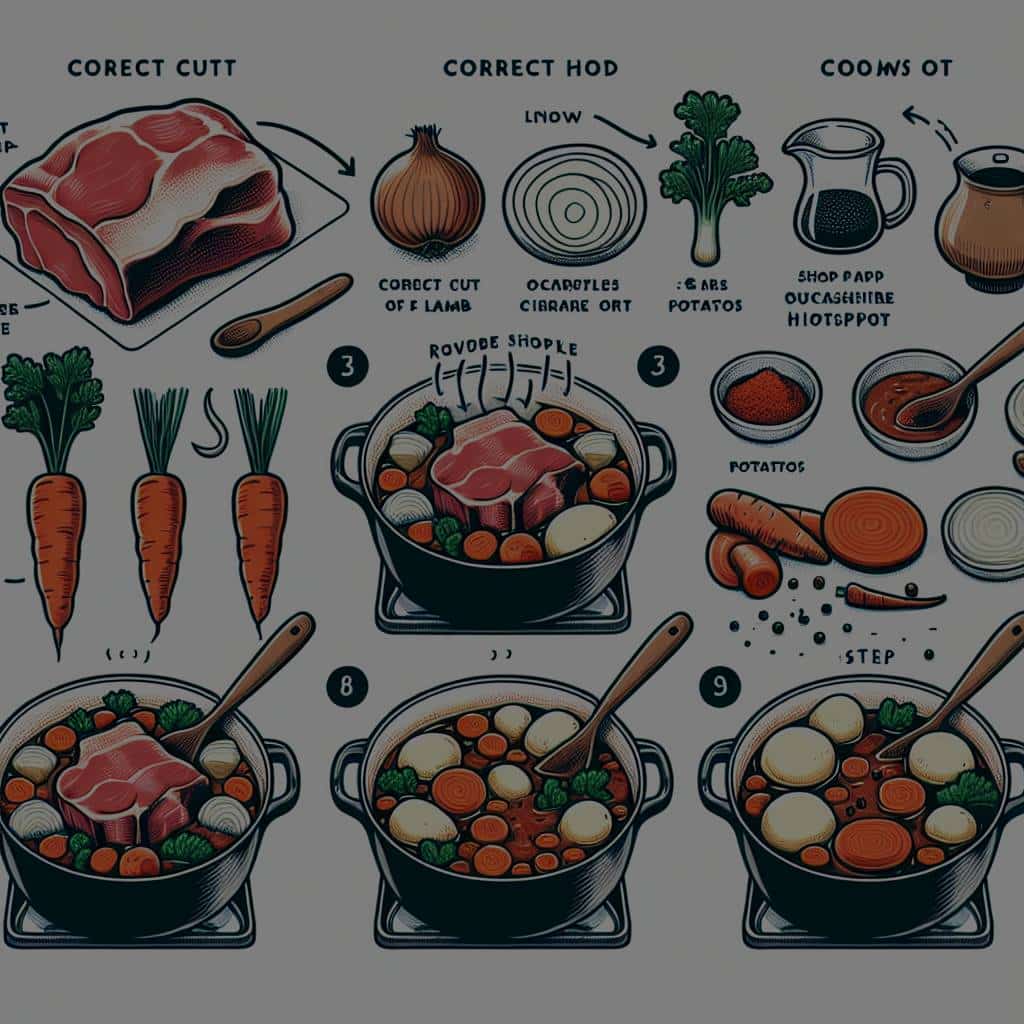How to Make a Traditional Lancashire Hotpot with the Right Cut of Lamb?

In this post, you will learn the secrets to making a traditional Lancashire Hotpot. This hearty dish, a classic from the county of Lancashire in Northern England, combines tender lamb, potatoes, and onions in a delicious stew topped with a golden crust. You will be guided step by step to recreate this recipe at home, with insider tips on choosing the right cut of lamb for the most flavourful result.
Selecting the Lamb Cut
The choice of lamb for your Lancashire Hotpot is crucial. The right cut will provide the dish with the depth of flavour and the succulent texture that are characteristic of this traditional dish.
A lire en complément : Can You Perfect the Art of an English Full Breakfast with Local Ingredients?
Many recipes recommend using a cut such as lamb’s neck or shoulder, as these cuts are rich in fat and therefore extremely flavourful. They also have a good amount of connective tissue, which breaks down during the slow cooking process, contributing to the rich, thick texture of the hotpot.
When you shop for lamb, pay attention to its colour and texture. The meat should be firm and look fresh. The colour should be a rich, rosy pink. Avoid any cut that has areas of dark colour or a sour smell.
En parallèle : What’s the Secret to a Flavorful Irish Soda Bread Using Authentic Ingredients?
Preparing the Meat and Vegetables
Preparation begins by seasoning the lamb pieces with salt. This not only adds flavor but also helps to draw out the juices from the meat, which will add depth and richness to the hotpot.
Next, peel and thinly slice the onions and potatoes. The onions should be translucent and soft, while the potatoes should retain their shape during cooking.
In a large casserole, melt some butter and add the onions. Cook them for about five minutes, until they are soft and translucent. Then, add the seasoned lamb pieces and brown them on all sides. This will seal in the juices and provide a robust flavour base for the hotpot.
Building the Lancashire Hotpot
Now that the lamb and onions are ready, you can start building your Lancashire Hotpot. In a large casserole or pot, arrange a layer of potatoes on the bottom. Next, add a layer of the browned lamb and onions. Repeat these layers until all the ingredients are used, ending with a layer of potatoes on top.
Pour in enough stock to just cover the ingredients. The type of stock you use can vary; lamb stock is traditional, but chicken or vegetable stock will also work well. The stock will simmer with the ingredients, infusing the entire dish with a hearty, savory flavour.
Cooking the Hotpot
The Lancashire Hotpot is known for its slow, gentle cooking time, which allows the flavours to meld together beautifully. Cover your casserole or pot and place it in a preheated oven at 170°C (about 338°F) for about 2 hours.
During this time, the hotpot will cook slowly and steadily, with the stock reducing and the flavours intensifying. The potatoes on top will become golden and crispy, providing a delightful contrast to the tender meat and vegetables underneath.
Finishing Touches
After the hotpot has been in the oven for 2 hours, remove the lid and increase the oven temperature to 200°C (about 392°F). This will allow the top layer of potatoes to crisp up and turn a beautiful golden brown.
Return the hotpot to the oven and continue to cook, uncovered, for an additional 30 minutes. Then, take it out of the oven and let it sit for a few minutes before serving.
Making a traditional Lancashire Hotpot is a labor of love that requires care and patience. But the result, a hearty, flavourful dish that warms you from the inside out, is well worth the effort. We hope this guide will help you master this classic dish, and that you and your loved ones will enjoy many cozy meals with this Lancashire favorite as the centerpiece.
The Secret Ingredients
So far, your Lancashire Hotpot includes a few basic ingredients – lamb, onions, and potatoes. However, traditional recipes often incorporate additional flavours and components that truly elevate the dish to another level.
Let’s begin with Worcestershire sauce. This unique ingredient, which has been a British pantry staple since the 19th century, adds a tangy, umami-rich balance to the richness of the lamb and the potatoes. You can add a few dashes of Worcestershire sauce to the lamb as it browns.
Next, consider adding bay leaves. Known for their pungent, slightly sweet aroma and flavour, bay leaves are traditionally used in stews and roasts. They infuse the Lancashire Hotpot with a subtle yet distinctive flavour. Simply add two or three bay leaves to your hotpot before it goes into the oven.
To fortify the flavours, some also add a spoonful of tomato paste when browning the lamb. This not only deepens the colour of the dish but also enhances its savouriness.
Lastly, consider serving your Lancashire Hotpot with a side of pickled red cabbage. The sharp, tangy taste of the cabbage provides a welcome contrast to the hearty hotpot.
Remember: your Lancashire Hotpot is only as good as the ingredients you put into it. So, choose your additional ingredients wisely and make your hotpot a gastronomic sensation.
Conclusion: Savouring Your Lancashire Hotpot
The process of creating a Lancashire Hotpot is indeed a labour of love. It requires time, patience, and a discerning palate. However, the result is a dish that is hearty, satisfying, and deeply embedded in the traditions of Lancashire cooking.
When serving your Lancashire Hotpot, do so from the casserole dish in which it was cooked. This allows everyone to appreciate the layered construction of the hotpot and to serve themselves a hearty helping of all the components.
To fully enjoy the slow-cooked lamb hotpot, it’s best served hot, straight from the oven, with the potatoes top golden and crispy, and the lamb and onions underneath tender and juicy. Just be sure to remove the bay leaves before serving, as they’ve done their job in flavouring the stew and are not meant to be eaten.
Pair it with a simple salad or some pickled red cabbage on the side, and you’ve got a meal fit for any occasion.
Now that you know the secrets of making a traditional Lancashire Hotpot, you are ready to recreate this homely and comforting dish in your own kitchen. Enjoy the process, and most importantly, savour every bite.
